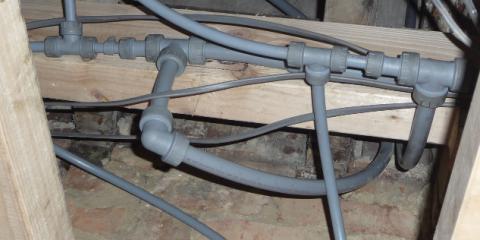This week has seen the (belated) start of 1st fix plumbing. The main contract includes all "domestic" plumbing, and the main contractors have subcontracted this to a guy they described as plumber, but who doesn't appear to be anything of the sort. Between them they've decided to use a plastic pipe system called Polypipe - and here I learnt a valuable lesson: next time, I'll specify in the tender documents that I expect plumbing to be done with copper pipe and solder fittings. As the contract doesn't specify any such thing, I now have to accept their chosen method, or be prepared to pay extra.
I ended up spending about half of today actually working on-site alongside the plumber, as this was the only practical way the work was going to get done to my satisfaction, in terms of pipe routes etc. I'm keen to minimise run lengths from the hot water cylinder to the wash basins and showers, in order to reduce water wastage due to people running off the standing water. Having worked with the Polypipe system myself, I can see it has its advantages: principally convenience, especially for a non-plumber who isn't fully tooled-up with blowtorch and pipe-bending machines; the pipe is flexible enough (even up to 22mm) to be fed through centre-drilled joist holes (something you could never do with copper, apart from 10mm); and it's cheaper than copper too.
The plumber seemed somewhat surprised, upon meeting me as the client, that I actually care about pipe routes and diameters. Presumably all his other domestic customers just want their kitchens and bathrooms to look nice and shiny, and don't ask any questions as long as the water comes out of the taps. Here's an example of his "spaghetti plumbing" (within the ceiling void above the ground-lloor bathroom):

